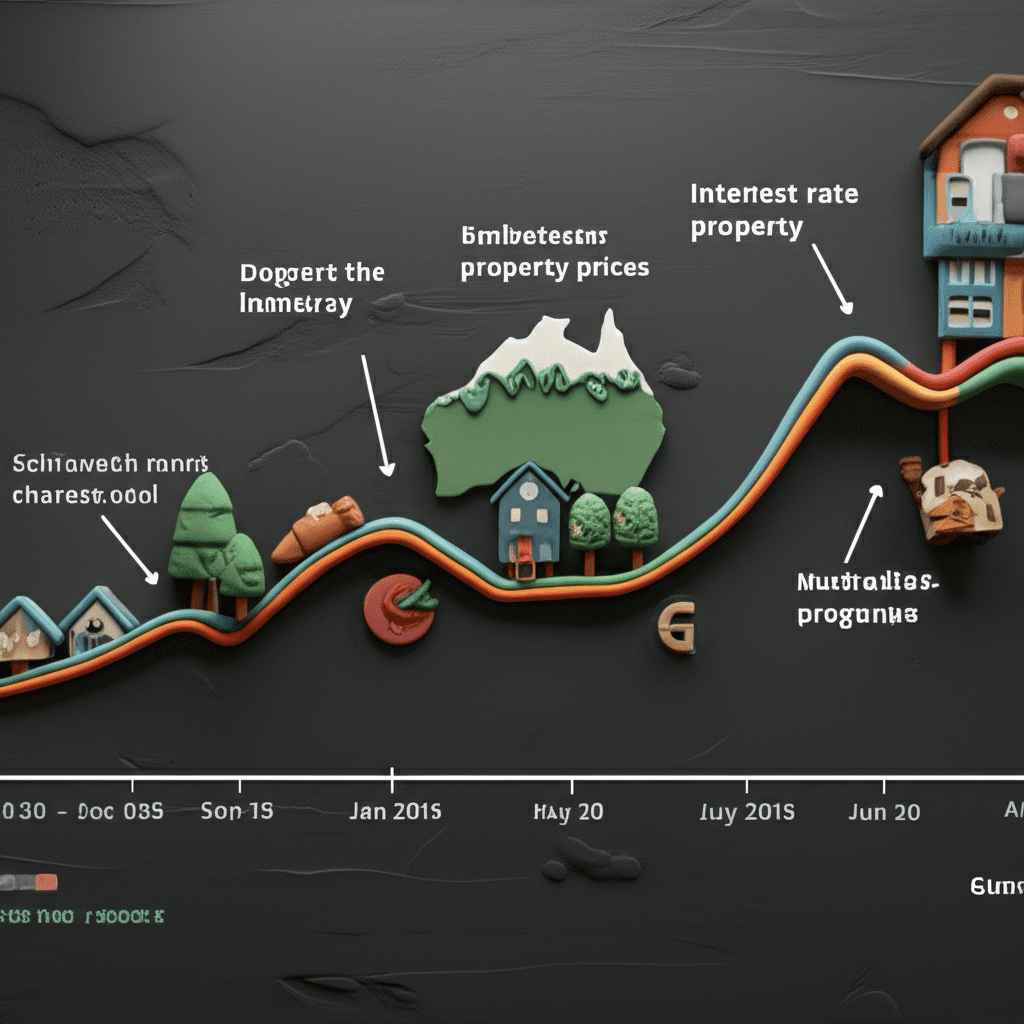The Investor's Guide to Mitigating Property Risk in Australia
Learn to identify and navigate common pitfalls, from market volatility to poor asset selection, using data-driven strategies.

Navigating the Australian property market in mid-2025 can feel overwhelming. With fluctuating interest rates, media hype, and endless advice, it's easy to feel paralyzed by the potential for a misstep. While property investing is often touted as 'safe as houses,' the reality is that it's a landscape filled with risks that can derail even the most ambitious portfolio goals. The good news is that nearly every risk can be understood, anticipated, and mitigated with the right knowledge and tools.
This guide breaks down the most significant risks facing Australian property investors today. We will move beyond the headlines to provide a strategic framework for making informed, confident decisions. By understanding the bigger picture, analysing specific locations, and scrutinising individual assets, you can build a resilient portfolio designed to weather storms and achieve long-term growth.
Market-Level Risks: The Bigger Picture
These are the large-scale, macroeconomic factors that can impact the entire property market. While you can't control them, you can prepare for them.
General Market & Economic Risk
General market risk encompasses external factors beyond an individual investor's control. The most prominent example is the fluctuation of interest rates, as seen in recent years. The Reserve Bank of Australia's decisions on the cash rate directly influence mortgage serviceability and can temper or stimulate property values. Beyond interest rates, wider economic events like recessions, global pandemics, or geopolitical conflicts can impact market sentiment and stability.
However, the fundamental need for housing provides a strong underlying support for the market. To mitigate these risks, the single most important strategy is maintaining a substantial cash buffer. A buffer equivalent to 6-12 months of mortgage repayments and expenses provides a crucial safety net, allowing you to hold your assets through downturns without being forced to sell at an inopportune time. Job security and access to liquidity are your best defences against unpredictable market shifts.
Legislative Risk
Governments at all levels can introduce changes that impact property investors. This can include:
Federal: Potential changes to negative gearing or capital gains tax concessions. While major changes like abolishing negative gearing have proven politically difficult in the past, it's a risk to remain aware of.
State: Policies like rent controls or changes to stamp duty can directly affect your cash flow and entry/exit costs. It's vital to stay informed via state revenue websites.
Local Council: Changes to local zoning and building regulations can influence future supply in an area. A seemingly quiet residential street could be rezoned for medium-density housing, impacting the character and value of your investment.
Monitoring council development plans and staying aware of state government housing policies is key to staying ahead of these changes.
Supply and Demand Dynamics
This is the core driver of property price growth. An oversupplied market will always struggle with capital growth, while an undersupplied market with strong demand is primed for appreciation. Protecting yourself from oversupply risk is crucial. This is where deep-dive real estate analytics become invaluable.
Be particularly cautious of Greenfield estates—large tracts of land being developed into new housing communities. While they can be appealing, the constant release of new land and house packages can suppress price growth for years. A key metric to watch is Stock on Market percentage. If an area consistently has a high percentage of properties for sale relative to its total housing stock, it's a red flag for oversupply.
Conversely, buying an established house in a built-up, land-locked area is a powerful long-term strategy to mitigate this risk, as new supply is physically constrained.

Location-Specific Risks: Choosing the Right Area
Not all markets move in unison. The specific characteristics of a city, region, or suburb are critical to your investment's success.
Economic Diversity & Location Risk
Investing in a town or region heavily reliant on a single industry, like mining, is a high-risk strategy. The fortunes of your property become tied to the boom-and-bust cycle of that one industry. The downturn in Perth's property market around 2015, following a decline in the resources sector, serves as a stark reminder. Prices went backwards for nearly five years.
To avoid this, prioritise locations with diverse job markets and multiple economic drivers. While you don't have to buy in a capital city, you should ensure the local economy is resilient. Using powerful data analytics to compare suburb-level economic indicators and population trends, like those published by the Australian Bureau of Statistics (ABS), helps you identify stable, growing regions.
New Infrastructure Risk
Infrastructure development is often a positive catalyst for growth, but it can also pose a risk. A new highway extension might bring a suburb closer to the city, but if your property is right next to it, the increased noise and traffic could devalue it. Similarly, new flight paths can negatively impact suburbs. Research from QUT on Brisbane's flight path changes in the 1980s showed affected suburbs underperformed for about four years before normalising.
Before purchasing, consult government resources like the Infrastructure Australia priority list and local council websites to understand planned projects. This due diligence helps you position your investment to benefit from new infrastructure, not be disadvantaged by it.
Environmental Risk
Properties in areas prone to environmental hazards like bushfires, floods, or cyclones carry higher risk and, often, higher insurance premiums. The devastating bushfires on the NSW South Coast and recent flooding events in Queensland and NSW highlight the real financial and emotional toll these events can take.
Use state government planning portals and flood maps to assess these risks. It's also wise to get several insurance quotes before committing to a purchase. If the premiums are prohibitively high, it's a clear signal from insurers that the risk is significant.

Asset & Tenant Risks: The Property Itself
Even in a great market, the wrong property or a bad tenant can turn a promising investment into a financial drain.
Poor Asset Selection
This is one of the most common mistakes. The ideal investment property has a high land-to-asset ratio, as it's the land that appreciates over time while the building depreciates. This is why houses generally outperform units for capital growth. Avoiding properties with high body corporate fees is also advisable, as these fees eat into your cash flow and you have limited control over their increases.
Always conduct a thorough building and pest inspection. Don't just read the report; call the inspector to discuss any major issues. Minor cosmetic fixes can be budgeted for, but structural problems, termites, or significant water damage can be financially ruinous.
Tenant & Management Risk
A vacant property generates no income. To mitigate vacancy risk, invest in areas with consistently low vacancy rates—a sign of strong rental demand. You can analyse this using detailed suburb data analytics. If you're buying a property with a tenant in place, request the rental ledger to check for a history of on-time payments.
A great property manager is a critical part of your team. They are your employee in your accommodation business. Interview them as such. A poor manager can cost you thousands in lost rent and unnecessary expenses. High staff turnover at an agency can be a warning sign.
Personal & Strategic Risks
These risks relate to your personal financial situation, your planning, and the advice you receive.
Financial & Leverage Risk
Leverage (using borrowed money) magnifies both gains and losses. Over-leveraging yourself—borrowing to your absolute limit—is extremely risky. As interest rates rise, a portfolio that was once positively geared can quickly become a significant cash flow drain. Be wary of non-bank lenders who may offer higher serviceability limits. While they can get you into a property, they often come with higher interest rates, and if the market turns, you may be trapped with no ability to refinance.
Your focus should be on your surplus cash flow. Understand exactly how a new purchase will impact your monthly budget and ability to continue saving. This is the foundation of sustainable portfolio growth.
Planning & Opportunity Cost Risk
Property investment is a long-term game that requires forward-thinking. Before you buy, consider your 3-5 year life plan. Are you planning on starting a family, changing careers, or buying your own home? Over-committing to investments could leave you without the borrowing capacity or cash reserves needed for these life goals.
The flip side of poor planning is procrastination, which leads to opportunity risk. While you should never feel rushed, waiting too long out of fear can mean missing out on significant growth. The key is to strike a balance: conduct thorough research, create a solid plan, and then execute with confidence.
Advice Risk
In a largely unregulated industry, the quality of advice can vary dramatically. Many so-called 'experts' are salespeople in disguise, motivated by commissions from developers rather than your best interests. Be skeptical of anyone promising guaranteed high returns or pushing you into off-the-plan apartments.
When engaging an advisor or buyer's agent, ask critical questions:
How do you get paid? (This reveals potential conflicts of interest).
Can you show me your portfolio's average performance, not just the highlights?
What is your experience and do you have any formal financial education?
A trustworthy advisor should act as a strategic partner. Our [AI Buyer's Agent](https://houseseeker.com.au/features/ai-buyers-agent), for example, is designed to provide data-driven, personalised guidance that aligns directly with your unique financial goals, removing the sales pressure from the process.
Conclusion
Property investing is not a risk-free endeavor, but it is a field where risk can be managed effectively. By shifting your focus from chasing hot spots to building a resilient, data-informed strategy, you can protect your capital and build sustainable wealth. Success lies not in avoiding risk entirely, but in understanding, planning for, and mitigating it at every step. From analysing macroeconomic trends to scrutinising a building and pest report, a diligent, analytical approach is your greatest asset.
Ready to move beyond guesswork and make investment decisions with clarity and confidence? Explore HouseSeeker's powerful [Real Estate Analytics Hub](https://houseseeker.com.au/features/real-estate-analytics) to access the suburb-level data and market insights you need to minimise risk and maximise returns.
Frequently Asked Questions
What is the most important first step to mitigate property investment risk?
The most critical first step is establishing a strong financial foundation. This means building a significant cash buffer (ideally 6-12 months of expenses and loan repayments), understanding your borrowing capacity conservatively, and having a clear picture of your monthly cash flow. Without this stability, any market downturn or unexpected expense can force you into a premature sale.
Are new housing estates (Greenfield estates) always a bad investment?
Not necessarily, but they are inherently higher risk. The primary danger is oversupply, as developers can continue releasing new blocks of land for years, which can suppress capital growth for existing homes. If you are considering a new estate, you must use detailed data analytics to scrutinise the long-term supply pipeline, the rate of land absorption, and the diversity of the local economy.
How can I avoid receiving bad property advice?
Due diligence is key. Always ask an advisor how they are compensated—hidden commissions from developers are a major red flag. Request to see their track record, asking for average performance figures, not just cherry-picked success stories. A reputable advisor or a tool like our AI Buyer's Agent will have a transparent process focused on your goals and backed by impartial data, not sales targets.
